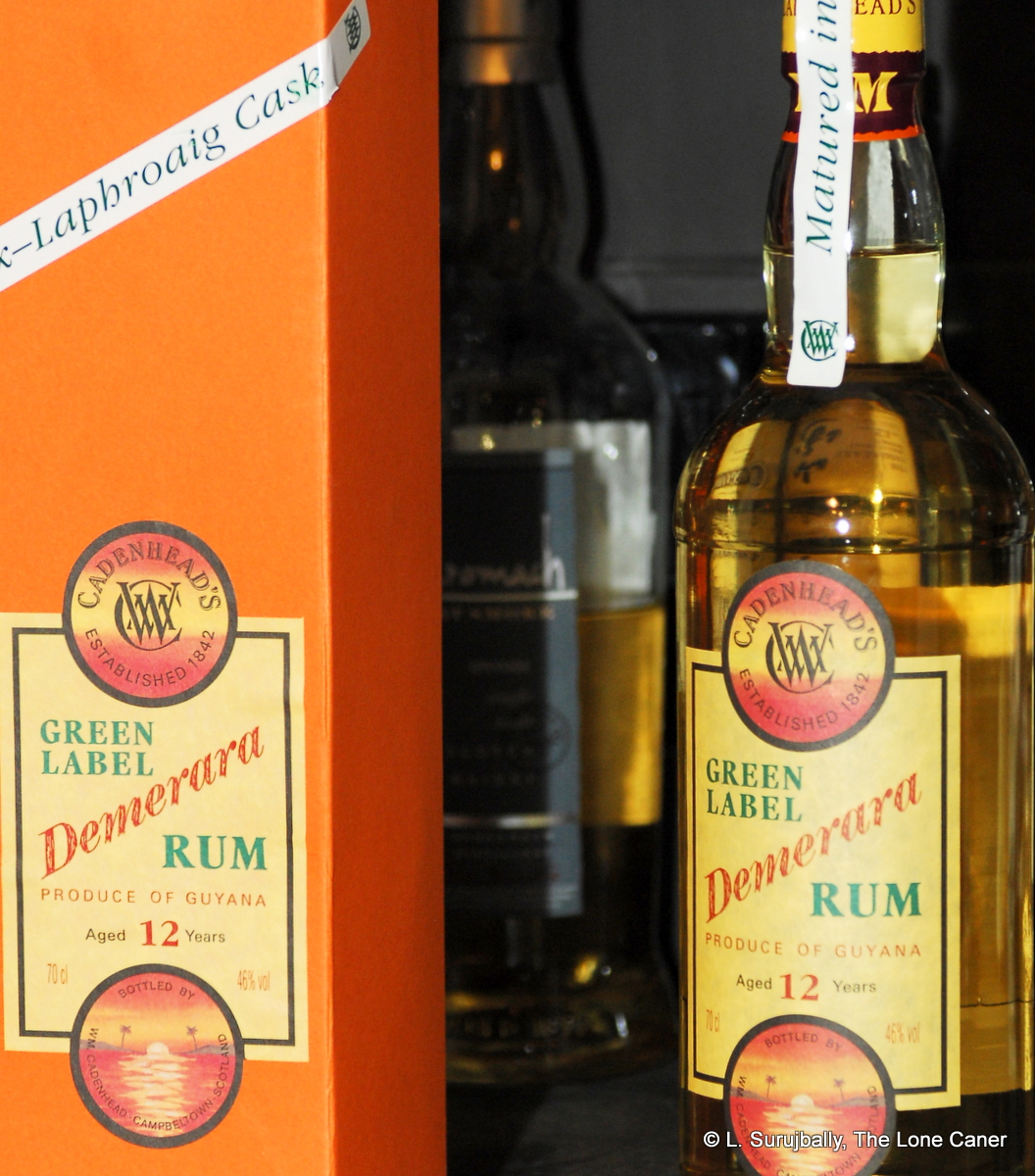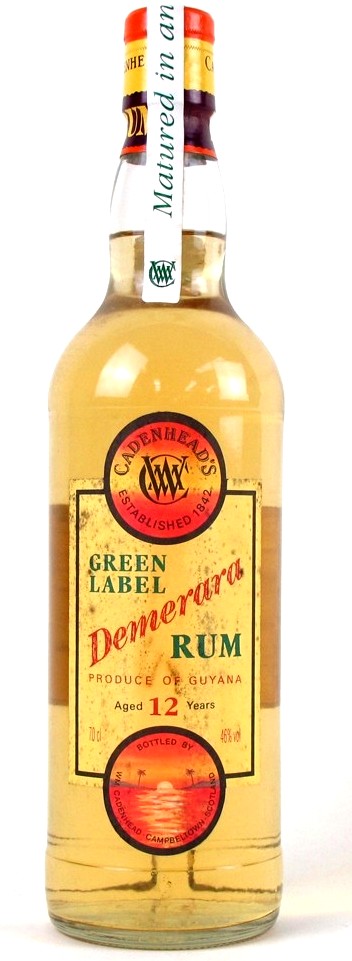
What a difference the passage of years makes. In 2010, a mere year after my long rum journey began, I came across and wrote about the Cadenhead 12 YO and gave it a rather dismissive rating of 76, remarking that while I liked it and while it had some underlying harmony, the decision to mature it in Laphroaig casks led to “not a rum, but some kind of bastardized in-the-middle product that isn’t fish or fowl.”
Later I began searching for it again, having in the interim gained rather more respect for what Cadenhead was doing. The Campbelltown-based company of course doesn’t need an introduction these days – famed more for its whiskies, it has for decades also dabbled in limited edition rum releases as part of its “Green Label” line, the best of which might be the near-legendary Guyanese editions of the 1975, the 1972 and the highly-sought-after 1964. Over the years they have released many editions of several countries’ rums, always unfiltered and unadded-to, and it’s become something of a recent running gag that they always put three- or four-letter character codes on their rums’ labels, of which even they no longer recall all the meanings.
 Anyway, this was a 12 year old, continentally-aged Guyanese rum (no still is mentioned, alas), of unknown outturn, aged 12 years in Laphroaig whisky casks and released at the 46% strength that was once a near standard for rums brought out by AD Rattray, Renegade, Cadenhead and others. The brevity and uninformativeness of the label dates the rum somewhat (modern iterations provide quite a bit more), but let’s just run with what we have here.
Anyway, this was a 12 year old, continentally-aged Guyanese rum (no still is mentioned, alas), of unknown outturn, aged 12 years in Laphroaig whisky casks and released at the 46% strength that was once a near standard for rums brought out by AD Rattray, Renegade, Cadenhead and others. The brevity and uninformativeness of the label dates the rum somewhat (modern iterations provide quite a bit more), but let’s just run with what we have here.
Nose first: short version, it’s interesting, a very strange amalgam of Demerara rum, agricole and a peaty whisky. It smells of rubber and wax, vaguely medicinal and iodine-like, is slightly sweet, quite light and there are more than a few yellow fruits parading around – pineapple, crisp Thai mangoes, green apples drizzled with lemon juice and tartly unsweetened yoghurt. After resting it goes a little nutty and leathery, but the real effects of ageing are minimal, and vanilla and oaky notes are to all intents and purposes, absent.
The taste was better, and again there’s that peculiar agricole-ness to the initial experience – sweet sugar water, lemonade, brine, olives, and a lot of crisp white fruits. It feels somewhat thin and rough on the tongue even with a “mere” 46% of proof, and could perhaps have used some additional ageing to round things off. The medicinal and peaty tastes were faint and walked off the stage after a while, to be replaced by aromatic tobacco, cheap wet coffee grounds used one too many times, cereal, all tied together by some cereal-like tastes, cinnamon and nutmeg. That said, if you’re hunting for traditional Demerara rum flavours like molasses, licorice and caramel, search elsewhere – they sure aren’t here. Finish was great though – hot, creamy and chewy. Very tasty, a good blend of yoghurt, pears, apples, lychees, grapefruit and fruit loops cereal.
So, what did I think? At the risk of boring you to tears, permit me this digression. When he was younger and we were discussing such matters, the Little Caner could never understand why I reread books (often several times) which I’d read before (often several more times). “You know what you’re getting,” he argued, with all the eloquence and conviction of a ten year old, “You know the plot, the background, everything. So why?” And then he would favour me with that pitying look that only young teens can master, which they save for their apparently doddering and drooling older relatives, would shake his head at my self-evident stubborn obtuseness, and then add his coupe-de-grace: “Do you expect the book to change or something?”
I bring up the matter because he was sitting beside me as I went through this sample, and asked me the same question. Given I had several dozens more to go through and the hourglass was running short, he wanted to know why I was wasting time. “Because, young zygote,” I responded, in that characteristically obscure way all the Caner Clan boys have of speaking to one another, “I’m not the same person who tried the original sample. I’m curious whether I’d like it less, more or the same as the first one, the first time.” I glanced slyly at him – “Sort of like the way, nowadays, you react differently to books you once enjoyed, but now don’t.”
He laughed, and acknowledged the point at last, and to cut further reminisces short, let me note that I appreciated the rum more than the one from all those years ago…but much of my initial opinion on its schizoid nature persists. I wasn’t entirely won over by the whisky cask ageing – rums have quite enough character of their own not to need such additional enhancement, thank you very much – but it was well assembled, well-integrated, and the Laph background enhanced rather more than detracted. It was just that it presented at odds with what we perhaps might prefer in a Demerara rum, lacked the distinct clarity of the wooden stills…and that medicinal peatiness?…well, I’m not convinced it works completely.
It will be up to each individual reading this review, however, to make up his or her own mind what they think of the rum; and perhaps, if they’re lucky, to come back to it a few times and see if their tastes evolve into an increased or decreased appreciation of what is, at end, quite a decent and interesting product. The way my boy has done with so many of his books.
(#700)(84/100)
Other Notes
The dates of distillation and bottling are unknown, but I’d suggest late 1990s early 2000s.